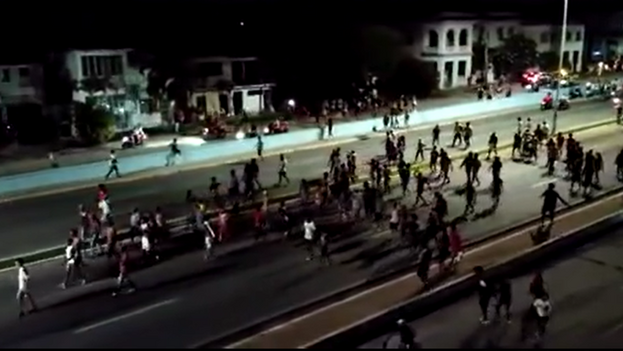
![]() 14ymedio, Havana, 1 October 2022 — After several days without electricity, Cubans took to the streets again on Friday night and the early hours of Saturday in Havana, where the protests have reached a massive level. Demonstrations have been documented in the municipalities of Playa, Arroyo Naranjo, Guanabacoa, Cerro, Marianao, Boyeros and Cojímar, and in the neighborhoods of Puentes Grandes, La Palma and Mantilla.
14ymedio, Havana, 1 October 2022 — After several days without electricity, Cubans took to the streets again on Friday night and the early hours of Saturday in Havana, where the protests have reached a massive level. Demonstrations have been documented in the municipalities of Playa, Arroyo Naranjo, Guanabacoa, Cerro, Marianao, Boyeros and Cojímar, and in the neighborhoods of Puentes Grandes, La Palma and Mantilla.
In the case of Cerro, the protest lasted until Saturday morning. Several neighbors have built barricades with garbage containers and are protesting without masks. A sign has been painted on the street: “Five days without light.”
The protest also continues in Guanabacoa, where residents have blocked 20th and Máximo Gómez streets, according to a source for 14ymedio.
“The police are supporting them, not assaulting them,” he says. “They blocked the four corners because they’ve been without electricity for four days, and all the food is spoiled.”
“Everyone is amazed,” says this newspaper’s contact, “because none of the agents has been aggressive. The police let them protest, waiting for them to get power.” Avoiding the confrontation seems to have been one of the constants of uniformed personnel during this Friday’s protests, which suggests that it’s a government direction — unlike what happened on July 11, 2021 — although several witnesses point to the presence in some places of government groups armed with sticks.
A video published on social networks shows how several young people, screaming “Go back, you’re disgusting!” prevent two police officers from the Ministry of the Interior from advancing on motorcycles and force them back.
In the municipality of Playa, where many leaders of the government leadership live and most of the embassies are located, the protests occupied about three blocks of 31st Avenue. “Get out!” and “freedom!” the crowd shouted at a flotilla of patrols, motorcycles and several police officers who dispersed along the street occupied by the demonstrators.
However, other images show the presence of civilian agents and Compulsory Military Service recruits, armed with sticks and shouting slogans in support of the regime, mobilized against the demonstrators in Playa, although there is no information about clashes between the two groups.
Another source of this newspaper reported that on Aranguren Street, between Ayestarán and Panchito Gómez, which marks the border between the municipalities of El Cerro and Plaza, a large number of police and civil agents were also concentrated, prepared to block access to the Plaza de la Revolución, where the buildings of several ministries and the nerve center of power are located.
“It’s one of the points that they are interested in having well controlled,” he said, “if the crowds manage to get to the Plaza it would be a symbolic defeat for Power.” There are suspected checkpoints at other key access points in the capital.
The police had prepared a cordon and several patrols, in case the demonstrators reached Saldo Street, a branch from Aranguren, but the protest didn’t reach that point. At 10:00 p.m., power returned.
A worker at José Martí International Airport, in Boyeros, told this newspaper that several demonstrators also blocked the streets leading to the air terminals. “The area in front of the airport has no power, but the terminals have a power plant and are working,” he said. “People don’t understand why they prioritize the airport and not the town; that’s why they wanted to go and throw stones.”
The president of the Provincial Defense Council of Havana, Luis Antonio Torres Iríbar, seems to have set the tone for not confronting the demonstrators. “I believe that protesting is a right,” he said on Cuban Television on Friday, although he clarified, adding that this right can only be exercised “when those responsible for the State and the Government are ceasing to do what is their responsibility.”
Then, Iríbar discredited Thursday’s demonstrations by stating that “yesterday’s protests, instead of helping, slow down the fulfillment of that mission.”
Most of the Island has not had electricity since September 27, and the fixed telephone poles have been damaged. Internet cuts by the Government and the breakage of telephone cables have made it difficult to report the situation, although a lot of information circulates on social networks about other protests this Friday in Holguín, Matanzas and other municipalities of Havana.
The lack of power also prevented the operation, during part of the night, of the servers of several official newspapers such as Cubadebate and the official website of the Communist Party, according to the Proyecto Inventario platform.
Translated by Regina Anavy
____________
COLLABORATE WITH OUR WORK: The 14ymedio team is committed to practicing serious journalism that reflects Cuba’s reality in all its depth. Thank you for joining us on this long journey. We invite you to continue supporting us by becoming a member of 14ymedio now. Together we can continue transforming journalism in Cuba.
